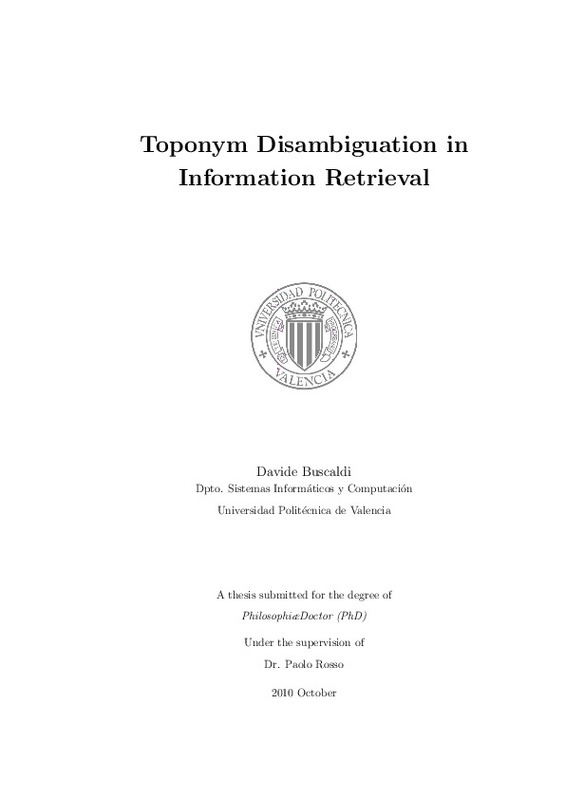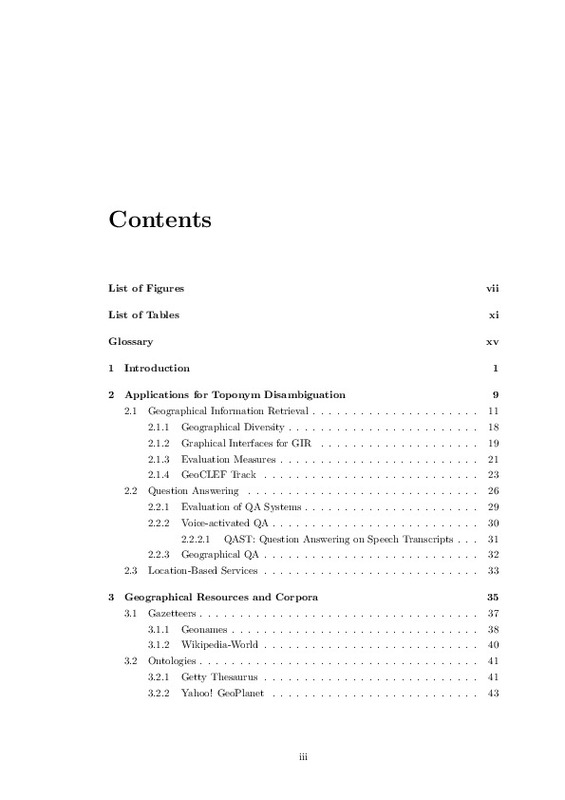- RiuNet repositorio UPV
- :
- Investigación
- :
- Tesis doctorales
- :
- Ver ítem
JavaScript is disabled for your browser. Some features of this site may not work without it.
Buscar en RiuNet
Listar
Mi cuenta
Estadísticas
Ayuda RiuNet
Admin. UPV
Toponym Disambiguation in Information Retrieval
Mostrar el registro sencillo del ítem
Ficheros en el ítem
| dc.contributor.advisor | Rosso ., Paolo
|
es_ES |
| dc.contributor.author | Buscaldi, Davide
|
es_ES |
| dc.date.accessioned | 2010-11-12T07:45:41Z | |
| dc.date.available | 2010-11-12T07:45:41Z | |
| dc.date.created | 2010-10-29T08:00:00Z | es_ES |
| dc.date.issued | 2010-11-12T07:45:38Z | es_ES |
| dc.identifier.uri | http://hdl.handle.net/10251/8912 | |
| dc.description.abstract | In recent years, geography has acquired a great importance in the context of Information Retrieval (IR) and, in general, of the automated processing of information in text. Mobile devices that are able to surf the web and at the same time inform about their position are now a common reality, together with applications that can exploit this data to provide users with locally customised information, such as directions or advertisements. Therefore, it is important to deal properly with the geographic information that is included in electronic texts. The majority of such kind of information is contained as place names, or toponyms. Toponym ambiguity represents an important issue in Geographical Information Retrieval (GIR), due to the fact that queries are geographically constrained. There has been a struggle to nd speci c geographical IR methods that actually outperform traditional IR techniques. Toponym ambiguity may constitute a relevant factor in the inability of current GIR systems to take advantage from geographical knowledge. Recently, some Ph.D. theses have dealt with Toponym Disambiguation (TD) from di erent perspectives, from the development of resources for the evaluation of Toponym Disambiguation (Leidner (2007)) to the use of TD to improve geographical scope resolution (Andogah (2010)). The Ph.D. thesis presented here introduces a TD method based on WordNet and carries out a detailed study of the relationship of Toponym Disambiguation to some IR applications, such as GIR, Question Answering (QA) and Web retrieval. The work presented in this thesis starts with an introduction to the applications in which TD may result useful, together with an analysis of the ambiguity of toponyms in news collections. It could not be possible to study the ambiguity of toponyms without studying the resources that are used as placename repositories; these resources are the equivalent to language dictionaries, which provide the di erent meanings of a given word. | es_ES |
| dc.language | Inglés | es_ES |
| dc.publisher | Universitat Politècnica de València | es_ES |
| dc.rights | Reserva de todos los derechos | es_ES |
| dc.source | Riunet | |
| dc.subject | Geographical information retrieval | es_ES |
| dc.subject | Toponym disambiguation | es_ES |
| dc.subject | Information retrieval | es_ES |
| dc.subject.classification | LENGUAJES Y SISTEMAS INFORMATICOS | es_ES |
| dc.title | Toponym Disambiguation in Information Retrieval | |
| dc.type | Tesis doctoral | es_ES |
| dc.identifier.doi | 10.4995/Thesis/10251/8912 | es_ES |
| dc.rights.accessRights | Abierto | es_ES |
| dc.contributor.affiliation | Universitat Politècnica de València. Departamento de Sistemas Informáticos y Computación - Departament de Sistemes Informàtics i Computació | es_ES |
| dc.description.bibliographicCitation | Buscaldi, D. (2010). Toponym Disambiguation in Information Retrieval [Tesis doctoral]. Universitat Politècnica de València. https://doi.org/10.4995/Thesis/10251/8912 | es_ES |
| dc.description.accrualMethod | Palancia | es_ES |
| dc.type.version | info:eu-repo/semantics/acceptedVersion | es_ES |
| dc.relation.tesis | 3382 | es_ES |
Este ítem aparece en la(s) siguiente(s) colección(ones)
-
Tesis doctorales [5389]







![Text file [Text]](/themes/UPV/images/text.png)


